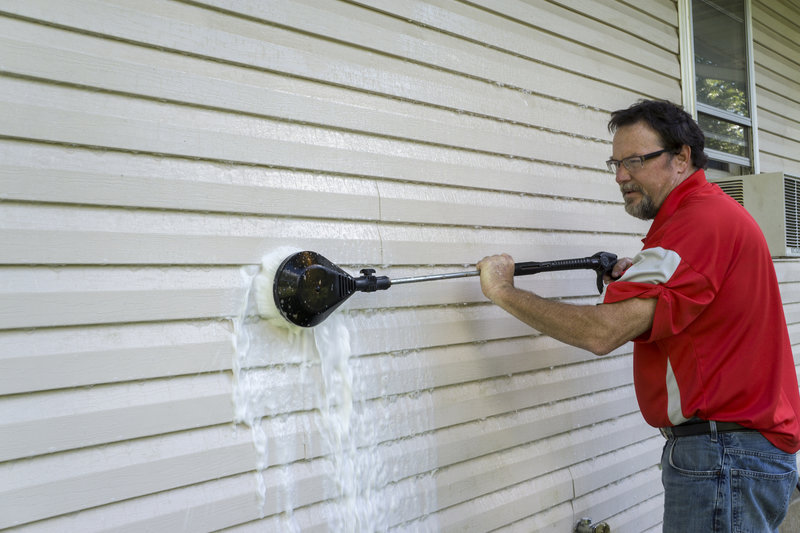
The great news about vinyl siding is that it lasts for decades, with minimal maintenance. That durability and longevity do, however, depend on routine maintenance. Routine cleaning, at least once per year, is the recommendation of every vinyl siding manufacturer we know of.
Annual Cleaning Keeps Vinyl Siding Looking Like New
In addition to ensuring your vinyl siding looks like a fresh coat of paint, routinely removing debris (dust, bird and pest waste, cobwebs, mold/mildew, etc.) also protects the siding from fading or unsightly discolorations.
In our mild climate, once per year may be enough. If you live in a more wet or shady region of the bay area, more frequent cleaning may be necessary to protect your siding from salt spray corrosion/fading and/or the damage done via mold, mildew, or algae build-up.
Also, as if looks weren’t enough, you’ll want to adhere to your siding manufacturer’s recommendations for how often the siding should be cleaned. Failure to follow their advice, or to have documentation proving you’ve cleaned it, could void the product’s warranty if there’s any chance lack of annual cleaning compromised the siding’s look or performance.
Simple Steps to Properly Clean Your Vinyl Siding
Cleaning vinyl siding is a simple job for a single–story home. If you live in a multi-story home, or you simply aren’t interested in a DIY job, you may want to call in the professionals. Speak with your roofing contractor and see if they’re up for the job. Sometimes, it’s simplest to bundle your annual roof inspection and cleaning with your vinyl siding cleaning, and you’ll have an invoice to tuck away as proof should you ever need to rely on the warranty.
Use the proper cleaning solution
Abrasive cleaners, or non-abrasive cleaners, run the risk of discoloring or corroding vinyl siding products. Check your manufacturer’s instructions (or find them online by searching your specific siding product) and follow them to the letter.
A general rule of thumb, according to the Vinyl Siding Institute, is, “NEVER use cleaners containing organic solvents, undiluted chlorine bleach, liquid grease remover, nail polish remover, or furniture polish or cleaners.
Universally approved solutions include:
- A 70% water/30% white vinegar solution, which is also useful for removing and killing mold/mildew
- A custom mix of green cleaning products, like Simple Green. A mild water/cleaning solution mixture is good for general cleaning; more potent mixes work better for dried bird/pest droppings and dirt/grime
- Customized concentrations of Murphy’s Soap Oil or Lysol and water work successfully to clean more stubborn stains such as rust or oil/grease, lawn/garden residue, rust, etc.
Always do a small spot test to make sure the cleaner works without damaging or discoloring your siding.
Have the right tools/accessories on hand
The more organized you are, the more efficiently you can get the job done. The most common tools and accessories used to clean vinyl siding safely include:
- Safety goggles and gloves
- A safe, well-maintained ladder
- Non-slip shoes or boots
- Power washer (with careful use, power washers are helpful. See more on that below)
- A 5-gallon bucket filled with your preferred cleaning solution
- A soft-bristled brush, preferably one with an extended handle. Brushes designed for washing a car work well here
- A hose and plenty of water
Gently spray, wash, and rinse
Gently spray sections of siding and then wash them, beginning at the bottom and continuing to the top. Stop as necessary to remove tougher-to-clean stains or residue. Always rinse the cleaning solution away entirely before allowing the siding to dry.
A note about power washing the vinyl siding
First and foremost, start by check with the manufacturer. Some manufacturers state that power washers should not be used on their products, and you’ll need to honor that. If they do not prohibit the use of power washers, always follow the power washer’s instructions.
Spray the water at eye level; never spray in an upwards or sideways direction. Doing so can cause water to get up and behind the moisture barriers. If this happens, you’ll compromise whole home comfort, indoor air quality, and the structural integrity of your exterior wall systems and siding. It’s best to avoid using the power washer altogether around window and door frames, as well as flashing products.
That’s that. Once your siding has been thoroughly washed, scrubbed, and completely rinsed, it will dry, looking better than ever.
One More Thing…
As long as you are up there, the team at Pacific Coast Roofing wants to remind you to check your gutters and remove any debris or blockage to protect your roof the next time it rains.

